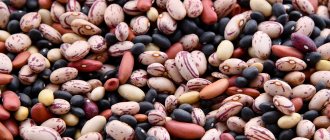Cholesterol is an organic compound found in cell membranes. Necessary for cell construction, synthesis of sex hormones, bile acids, and nutrient metabolism. It plays an important role in the human body, but sometimes causes significant harm.
There are two types of cholesterol in the blood: “good” (HDL) and “bad” (LDL). An increase in the concentration of the latter becomes the main cause of the formation of plaques in blood vessels, resulting in an increased risk of stroke and heart attack. High cholesterol levels are dangerous to health, so they need to be reduced. The most effective methods will be discussed in the article.
Oatmeal, oat bran and fiber-rich foods
Oatmeal contains soluble fiber, which lowers low-density lipoprotein (LDL) levels, the so-called “bad” cholesterol. Soluble fiber is also found in beans, apples, pears, barley and prunes.
Soluble fiber can lower the amount of cholesterol in the blood. 5-10 grams or more of soluble fiber per day reduces total cholesterol and LDL cholesterol. One and a half cups of oatmeal contains 6 grams of fiber. If you add some fruit, such as banana, to your porridge, you'll get about 4 more grams of fiber. For variety, try unprocessed oats or rolled oats containing oat groats or oat bran.
Complications from high cholesterol
High cholesterol is dangerous because it increases the likelihood of developing the following diseases:
- atherosclerosis – accompanied by the formation of atherosclerotic plaques, decreased elasticity of vessel walls, and narrowing of the arteries;
- coronary heart disease – accompanied by narrowing of the coronary artery, which causes myocardial hypoxia and disrupts its functioning;
- hypertension - manifests itself as high blood pressure, against the background of which stroke, heart attack, heart failure and other serious complications are likely;
- stroke - an acute disorder of cerebral circulation as a result of blockage or rupture of a cerebral vessel;
- heart attack – death of a section of the heart muscle due to loss of blood supply.
Most of these diseases are known to be fatal.
High cholesterol at a young age causes early disability and mortality. Due to the increased concentration of LDL, the walls of blood vessels become less elastic, atherosclerotic plaques are deposited on them, which impede blood flow. As a result, blood clots form, which cause heart attack and stroke.
Signs of High Cholesterol:
- heart pain, angina attacks;
- heaviness, pain in the legs even after minor physical exertion;
- the appearance of blood clots with mild bleeding;
- yellow spots on the skin, mainly in the eye area, wen.
More severe symptoms of high cholesterol in men and women appear when LDL levels are at critical levels. This may be a pre-stroke or pre-infarction condition.
The earlier high cholesterol and its causes are identified, the more effective the treatment.
Fish and omega-3 fatty acids
Fish and omega 3 fatty acids
Eating fatty fish is good for your heart because it contains high amounts of omega-3 fatty acids, which reduce blood pressure and the risk of blood clots. In people who have had heart attacks, fish oil and omega-3 fatty acids reduce the risk of sudden death.
Cardiologists recommend eating at least 2 servings of fish per week. The largest amounts of omega-3 fatty acids contain:
- mackerel;
- river trout;
- herring;
- sardines;
- longfin tuna;
- salmon;
- halibut.
To avoid adding unhealthy fats, fish should be baked or grilled. If you don't like fish, you can get some omega-3 fatty acids from foods like flaxseed meal, camelina oil, or canola oil.
Another option is to take omega-3 fatty acid or fish oil supplements, but then you won't get other nutrients that fish also contain (such as selenium). If you plan to use such supplements, please consult your physician first.
Walnuts, almonds and other nuts
Benefits of nuts
Walnuts, almonds and other nuts can improve your cholesterol levels. Rich in mono- and polyunsaturated fatty acids, walnuts also help support vascular health.
Eating a handful of almost any type of nut (almonds, hazelnuts, peanuts, pecans, pine nuts, pistachios, walnuts) daily can reduce your risk of heart disease. When choosing nuts, make sure that they are without added salt or sugar.
All nuts are high in calories, so a handful (40-45 g) will be enough. To avoid overeating and weight gain, replace foods rich in saturated fat with nuts. For example, instead of cheese, meat or croutons, add a handful of walnuts or almonds to your salad.
Cholesterol is necessary for the human body, but excess of it is definitely harmful. Deviation from the norm in the direction of lowering cholesterol concentration is also dangerous.
Cholesterol is a fat-like substance that is vital for humans. It is part of the membranes (membranes) of all cells in the body, there is a lot of cholesterol in nervous tissue, and many hormones are formed from cholesterol. About 80% of cholesterol is produced by the body itself, the remaining 20% comes from food. Atherosclerosis occurs when there is a lot of low-density cholesterol in the blood. It damages the lining of the inner wall of the vessel, accumulates in it, resulting in the formation of atherosclerotic plaques, which then turn into mush, calcify and clog the vessel. High levels of cholesterol in the blood mean an increased risk of heart disease. Our organs contain approximately 200 grams of it, and there is especially a lot of it in the nervous tissue and brain.
For a long time, cholesterol was considered literally the personification of evil. Foods containing cholesterol were outlawed, and cholesterol-free diets were extremely popular. The main accusation was based on the fact that atherosclerotic plaques on the inner surface of blood vessels contain cholesterol. These plaques cause atherosclerosis, that is, a violation of the elasticity and patency of blood vessels, and this, in turn, is the cause of heart attacks, strokes, brain diseases and many other ailments. In fact, it turned out that to prevent atherosclerosis, it is important not only to monitor cholesterol levels, but also to pay attention to many factors. Infectious diseases, physical activity, the state of the nervous system, and finally, heredity - all this affects the blood vessels and can provoke atherosclerosis or, conversely, protect against it.
And with cholesterol itself, everything turned out to be not so simple. Scientists have found that there are both “bad” and “good” cholesterol. And to prevent atherosclerosis, it is not enough to reduce the level of “bad” cholesterol. It is important to maintain the “good” level at the proper level, without which the normal functioning of internal organs is impossible.
Every day, the average person's body synthesizes from 1 to 5 g of cholesterol. The largest proportion of cholesterol (80%) is synthesized in the liver, some is produced by body cells, and 300-500 mg comes from food. Where do we spend all this? About 20% of the total amount of cholesterol in the body is found in the brain and spinal cord, where this substance is a structural component of the myelin sheath of nerves. In the liver, bile acids are synthesized from cholesterol, which are necessary for the emulsification and absorption of fats in the small intestine. 60-80% of the cholesterol produced daily in the body is spent on these purposes. A small part (2-4%) goes to the formation of steroid hormones (sex hormones, adrenal hormones, etc.). Some cholesterol is used to synthesize vitamin D in the skin under the influence of ultraviolet rays and to retain moisture in body cells. Thanks to laboratory studies conducted by a group of researchers in Germany and Denmark, it was found that a component of blood plasma that can not only bind, but also neutralize dangerous bacterial toxins is low-density lipoproteins - carriers of the so-called “bad” cholesterol. It turns out that “bad” cholesterol helps support the human immune system. Therefore, you just need to make sure that the level of “bad” cholesterol does not exceed the known norm, and everything will be fine.
In men, strict adherence to cholesterol-free products can negatively affect sexual activity, and in women who are too active in the fight against cholesterol, amenorrhea often occurs. Dutch doctors claim that low levels of this substance in the blood are to blame for the spread of mental illness among Europeans. Experts advise: if you have depression, you need to do a blood test for cholesterol - perhaps it is its deficiency that deprives you of the joy of life.
Other studies have shown that the most favorable ratio of “bad” and “good” cholesterol in the blood is observed in people whose diet contains 40-50 percent fat. For those who practically do not consume fat, the blood content of not only “harmful” cholesterol, which is involved in the formation of atherosclerotic plaques, is reduced, but also its beneficial forms, which protect blood vessels from atherosclerosis.
It is very important that “good” and “bad” cholesterol are balanced in relation to each other. Their ratio is determined as follows: the total cholesterol content is divided by the “good” cholesterol content. The resulting number must be less than six. If there is too little cholesterol in the blood, then this is also bad.
Normal levels of cholesterol in the blood According to the official recommendations of the European Society of Atherosclerosis (a very respected organization in the West), “normal” levels of fatty fractions in the blood should be as follows: 1. Total cholesterol - less than 5.2 mmol/l. 2. Low-density lipoprotein cholesterol - less than 3-3.5 mmol/l. 3. High-density lipoprotein cholesterol - more than 1.0 mmol/l. 4. Triglycerides - less than 2.0 mmol/l.
How to eat right to lower cholesterol It is not enough to simply give up foods that cause the production of “bad” cholesterol. It is important to regularly consume foods containing monounsaturated fats, omega-polyunsaturated fatty acids, fiber, and pectin to maintain normal levels of “good” cholesterol and help remove excess “bad” cholesterol.
Healthy cholesterol is found in fatty fish, such as tuna or mackerel. Therefore, eat 100 g of sea fish 2 times a week. This will help keep the blood in a thin state and prevent the formation of blood clots, the risk of which is very high with high levels of cholesterol in the blood.
Nuts are a very fatty food, but the fats contained in various nuts are mostly monounsaturated, that is, very beneficial for the body. It is recommended to eat 30 g of nuts 5 times a week, and for medicinal purposes you can use not only hazelnuts and walnuts, but also almonds, pine nuts, Brazil nuts, cashews, and pistachios. Sunflower, sesame and flax seeds perfectly increase the level of healthy cholesterol. You eat 30 g of nuts by eating, for example, 7 walnuts or 22 almonds, 18 cashews or 47 pistachios, 8 Brazil nuts.
Among vegetable oils, give preference to olive, soybean, flaxseed oil, and sesame seed oil. But under no circumstances fry in oils, but add them to prepared food. It is also healthy to simply eat olives and any soy products (but make sure that the packaging states that the product does not contain genetically modified components).
To remove “bad” cholesterol, be sure to eat 25-35 g of fiber per day. Fiber is found in bran, whole grains, seeds, legumes, vegetables, fruits and greens. Drink bran on an empty stomach, 2-3 teaspoons, be sure to wash it down with a glass of water.
Don't forget about apples and other fruits that contain pectin, which helps remove excess cholesterol from the blood vessels. There are a lot of pectins in citrus fruits, sunflowers, beets, and watermelon rinds. This valuable substance improves metabolism, removes toxins and heavy metal salts, which is especially important in unfavorable environmental conditions.
To remove excess cholesterol from the body, juice therapy is indispensable. Among fruit juices, orange, pineapple and grapefruit (especially with the addition of lemon juice), as well as apple, are especially useful. Any berry juices are also very good. Among vegetable juices, traditional medicine recommends potent juices of beets and carrots, but if your liver is not working perfectly, start with a teaspoon of juice.
Green tea is very useful for high cholesterol; it kills two birds with one stone - it helps increase the level of “good” cholesterol in the blood and reduces the level of “bad” cholesterol. Also, in consultation with your doctor, it is good to use mineral water in treatment.
An interesting discovery was made by British scientists: 30% of people have a gene that increases the amount of “good” cholesterol. To wake up this gene, you just need to eat every 4-5 hours at the same time.
It is believed that consuming butter, eggs, and lard significantly increases blood cholesterol levels, and it is better to avoid consuming them altogether. But recent studies prove that the synthesis of cholesterol in the liver is inversely related to its amount coming from food. That is, synthesis increases when there is little cholesterol in food, and decreases when there is a lot of it. Thus, if you stop eating foods containing cholesterol, it will simply begin to form in large quantities in the body.
To maintain cholesterol levels within normal limits, first of all, avoid saturated and especially refractory fats contained in beef and lamb fat, and also limit the consumption of butter, cheese, cream, sour cream and whole milk. Remember that “bad” cholesterol is only found in animal fats, so if your goal is to lower your blood cholesterol levels, then reduce your intake of animal foods. Always remove the fatty skin from chicken and other poultry, which contains almost all the cholesterol.
When you cook meat or chicken broth, after cooking, cool it and skim off the congealed fat, since it is this refractory type of fat that causes the greatest harm to blood vessels and increases the level of “bad” cholesterol.
The likelihood of developing atherosclerosis is minimal if you: • are cheerful, at peace with yourself and with the people around you; • do not smoke; • don't drink alcohol; • love long walks in the fresh air; • are not overweight and have normal blood pressure; • do not have hormonal abnormalities.
How to lower cholesterol with folk remedies Linden to lower cholesterol A good recipe for high cholesterol: take dried linden flower powder. Grind linden flowers into flour in a coffee grinder. Take 1 tsp 3 times a day. such fake flour. Drink for a month, then break for 2 weeks and take linden for another month, washing it down with plain water. At the same time, follow a diet. Eat dill and apples every day, because dill contains a lot of vitamin C, and apples contain pectin. All this is beneficial for blood vessels. And it is very important to normalize cholesterol levels by improving the functioning of the liver and gallbladder. To do this, take infusions of choleretic herbs for two weeks, taking a break for a week. These are corn silk, immortelle, tansy, milk thistle. Change the composition of the infusion every 2 weeks. After 2-3 months of using these folk remedies, cholesterol returns to normal, and a general improvement in well-being is observed.
Propolis for removing “bad” cholesterol To cleanse blood vessels of cholesterol, you need to take 7 drops of 4% propolis tincture dissolved in 30 ml of water 3 times a day, 30 minutes before meals. The course of treatment is 4 months.
Beans will lower cholesterol Cholesterol levels can be reduced without problems! In the evening, pour half a glass of beans or peas with water and leave overnight. In the morning, drain the water, replace it with fresh water, add a teaspoon of baking soda to the tip (to prevent gas formation in the intestines), cook until tender and eat this amount in two doses. The cholesterol-lowering course should last three weeks. If you eat at least 100 g of beans per day, your cholesterol level decreases by 10% during this time.
Alfalfa will remove “bad” cholesterol. One hundred percent remedy for high cholesterol is the leaves of alfalfa. You need to treat with fresh herbs. Grow at home and, as soon as the sprouts appear, cut them and eat them. You can squeeze the juice and drink 2 tbsp. 3 times a day. The course of treatment is a month. Alfalfa is very rich in minerals and vitamins. It can also help with diseases such as arthritis, brittle nails and hair, and osteoporosis. When your cholesterol levels are normal in all respects, follow a diet and eat only healthy foods.
Flaxseed to lower cholesterol You can lower the level of bad cholesterol with flaxseed, which is sold in pharmacies. Add it to the food you eat regularly. You can first grind it in a coffee grinder. The pressure will not jump, the heart will become calmer, and at the same time the functioning of the gastrointestinal tract will improve. All this will happen gradually. Of course, the diet should be healthy.
Healing powder for lowering cholesterol Buy linden flowers at the pharmacy. Grind them in a coffee grinder. Every day, take 1 teaspoon of powder 3 times. Course 1 month. By doing this you will lower cholesterol in the blood, remove toxins from the body and at the same time lose weight. Some people lost 4 kg. Your health and appearance will improve.
Dandelion roots for atherosclerosis to remove excess cholesterol in the blood from the body Dry powder of crushed dry roots is used for atherosclerosis to remove excess cholesterol from the body and remove harmful substances. 1 tsp is enough. powder before each meal, and after 6 months there is an improvement. There are no contraindications.
Eggplants, juices and rowan berries will lower cholesterol. Eat eggplants as often as possible, add them raw to salads, after holding them in salt water to remove the bitterness. In the morning, drink tomato and carrot juices (alternate). Eat 5 fresh red rowan berries 3-4 times a day. The course is 4 days, the break is 10 days, then the course is repeated 2 more times. It is better to carry out this procedure at the beginning of winter, when frosts have already “hit” the berries.
Celery will lower cholesterol and cleanse blood vessels. Chop the celery stalks in any quantity and put them in boiling water for a couple of minutes. Then take them out, sprinkle with sesame seeds, lightly salt and sprinkle with a little sugar, add sunflower or olive oil to taste. It turns out to be a very tasty and satisfying dish, absolutely light. They can have dinner, breakfast and just eat at any time. One condition - as often as possible. True, if you have low blood pressure, then celery is contraindicated.
Licorice will remove bad cholesterol 2 tbsp. crushed licorice roots, pour 0.5 liters of boiling water, simmer over low heat for 10 minutes, strain. Take 1/3 tbsp. decoction 4 times a day after meals for 2 - 3 weeks. Then take a break for a month and repeat the treatment. During this time, cholesterol will return to normal!
Prevention of high cholesterol To prevent the deposition of cholesterol on the walls of blood vessels, you need to adjust your diet. There is a lot of cholesterol in red meat and butter, as well as in shrimp, lobsters and other shelled animals. Ocean fish and shellfish have the least cholesterol. They also contain substances that help remove cholesterol from cells, including cells of internal organs. Eating large amounts of fish and vegetables reduces cholesterol levels in the blood and prevents obesity and cardiovascular diseases - the main cause of death in the civilized population.
In order to control cholesterol levels, you need to do a special blood test every six months. The normal level of “bad” cholesterol ranges from 4-5.2 mmol/l. If the level is higher, then you need to see a doctor.
Olive oil
The benefits of olive oil
Another good source of MUFA is olive oil.
To benefit your heart, try to consume 2 tablespoons (23 g) of olive oil daily, replacing other fats. You can sauté vegetables in olive oil, add it to marinades, or mix it with vinegar for salad dressings. When frying meat, use olive oil instead of butter.
Both avocados and olive oil are high-calorie foods, so don't eat more than the recommended amount.
Products with added plant sterols and stanols
Products are available that are fortified with sterols or stanols, plant substances that block the absorption of cholesterol.
Some margarines, orange juice and drinking yogurts with added plant sterols can reduce LDL levels by 5-15%. To see results, you need to consume at least 2 grams of plant sterols per day, which equates to about 2 glasses of sterol-fortified orange juice.
It is unclear whether foods containing plant sterols and stanols reduce the risk of heart attacks and strokes, although experts believe that cholesterol-lowering foods also reduce the risk of cardiovascular complications. Plant sterols and stanols do not affect the level of triglycerides and high-density lipoproteins (HDL), the so-called “good” cholesterol.
Combined lipid-lowering therapy
In some cases, doctors prescribe a combination of lipid-lowering drugs with different mechanisms of action. The most common indication is severe hyperlipidemia. Most often, fibrates are used in combination with statins. Nicotinic acid is combined with other hyperlipidemic drugs very carefully, under the supervision of a physician [6].
If a two-component treatment regimen is ineffective, three drugs can be used at once, for example, statins, cholesterol absorption inhibitors and nicotinic acid [3].
Sources
- Kharkevich D.A. Pharmacology. 10th ed. M.: GEOTAR-Media, 2010. – 908 p.
- Morris Brown, Peter Bennett. Clinical Pharmacology 11th Edition, 2012.
- Clinical pharmacology and pharmacotherapy: textbook. – 3rd ed., add. and processed / ed. V.G. Kukesa, A.K. Starodubtseva. – M.: GEOTAR-Media, 2012. – 832 p.
- Bardal SK, Waechter JE, Martin DS Applied pharmacology. – Elsevier Health Sciences, 2011.
- Goodman and Gilman's The Pharmacological Basis of Therapeutics, Twelfth Edition
- Janashia P.Kh. et al. Drug lipid-lowering therapy. Medi.ru URL: https://medi.ru/info/3448/ (access date 05/29/2020).
Other dietary changes
For these products to really be beneficial, you will have to reconsider your diet and adjust your lifestyle.
Although the benefits of some types of fats were discussed above, the consumption of others - saturated fats and trans fats - should be limited. Saturated fats, found in meats, butter, cheese and other full-fat dairy products, as well as some vegetable oils, raise total cholesterol levels. Trans fats, often used in margarines or store-bought cookies, crackers or cakes, are especially unhealthy. They increase LDL and decrease HDL - the so-called. “good” cholesterol. If a product label says “partially hydrogenated oils,” the product contains trans fats and is best avoided.
In addition to changing your diet, you should also adjust your overall lifestyle - this is the key to improving your cholesterol levels. Exercise, quitting smoking and maintaining a healthy weight will help you normalize your cholesterol levels.
Make an appointment Do not self-medicate. Contact our specialists who will correctly diagnose and prescribe treatment.
Summing up
Increasing cholesterol is a process that is not always noticeable even to the person himself. At first, you are worried about excessive fatigue, memory impairment, and the inability to spend a long time in physical stress. As plaques form on the walls of the capillaries, headaches, chronic fatigue, sleep disturbances and pressure surges occur.
You need to start getting rid of such symptoms immediately and using an integrated approach. It is recommended to immediately visit a specialist, donate blood for a detailed analysis, and then follow the doctor’s advice, follow a diet, give up bad habits and take prescribed medications.











